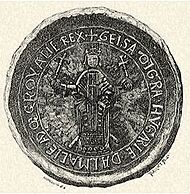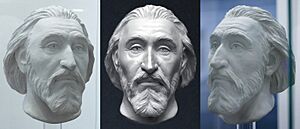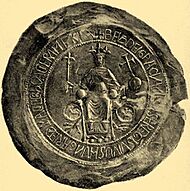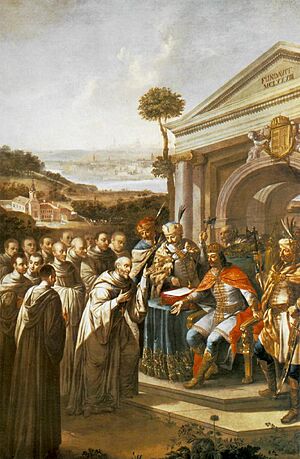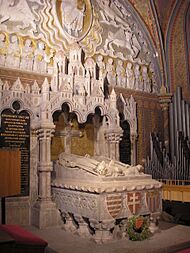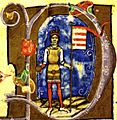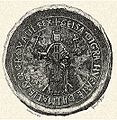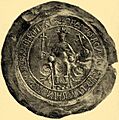Béla III of Hungary facts for kids
Quick facts for kids Béla III |
|
|---|---|

Bela III from the Illuminated Chronicle
|
|
| King of Hungary and Croatia | |
| Reign | 4 March 1172 – 23 April 1196 |
| Coronation | 13 January 1173, Székesfehérvár |
| Predecessor | Stephen III |
| Successor | Emeric |
| Born | c. 1148 |
| Died | 23 April 1196 (aged 47–48) |
| Burial | Székesfehérvár Basilica reburied at Matthias Church |
| Spouse |
|
| Issue |
|
| Dynasty | Árpád dynasty |
| Father | Géza II of Hungary |
| Mother | Euphrosyne of Kiev |
| Religion | Roman Catholic |
Béla III (born around 1148, died April 23, 1196) was a powerful King of Hungary and Croatia. He ruled from 1172 to 1196. Béla was the second son of King Géza II and Queen Euphrosyne of Kiev.
Around 1161, his father gave Béla a special territory to rule, called a duchy. This duchy included Croatia, parts of Dalmatia, and possibly Sirmium. In 1163, Béla moved to Constantinople, the capital of the Byzantine Empire. This happened because of a peace treaty between his older brother, King Stephen III, and the Byzantine Emperor Manuel I Komnenos.
In Constantinople, Béla was renamed Alexios. The emperor gave him a very important new title, despotes, which meant "lord." He was also engaged to the emperor's daughter, Maria. However, Béla's lands caused fighting between Hungary and the Byzantine Empire. Stephen III tried to stop the Byzantines from taking control of Croatia, Dalmatia, and Sirmium. Béla-Alexios, who was even named as Emperor Manuel's future heir in 1165, joined the Byzantine army in campaigns against Hungary.
In 1169, the emperor had a son, Alexios. This meant Béla was no longer the heir. His engagement was called off, and his high title was changed to a lower one, kaisar.
When Stephen III died in 1172, Béla decided to return to Hungary. He promised the Byzantine emperor he would never fight against the Byzantine Empire. Hungarian leaders wanted Béla to be king, but Lucas, Archbishop of Esztergom, disagreed. He thought Béla had tried to buy his way to the throne, which is called simony. Finally, with the Pope's approval, the Archbishop of Kalocsa crowned Béla king on January 18, 1173.
Béla also had conflicts with his younger brother, Géza, whom he kept imprisoned for over ten years. After Emperor Manuel died, Béla took back Croatia, Dalmatia, and Sirmium between 1180 and 1181. He also took over the Principality of Halych in 1188, but lost it within two years.
King Béla was known for making official records more common in Hungary. Some old stories even say he created the Royal Chancery, which was like a government office for writing documents. The royal palace he built in Esztergom was one of the first examples of Gothic architecture in Central Europe. Some records suggest he was one of the richest kings in Europe at the time, but historians still debate how accurate these records are.
Contents
Early Life and Royal Connections
Growing Up (around 1148–1163)
Béla was the second son of King Géza II of Hungary and Queen Euphrosyne of Kiev. We don't know his exact birth date. However, studies of his bones show he was about 49 when he died in 1196. This means he was likely born around 1148.
Béla's father, Géza II, gave him a special territory to rule. This was called an appanage, a common practice for younger royal sons. This land included parts of Dalmatia, like Šibenik, Split, and Trogir. These cities had been under Hungarian rule for a long time. Historians believe Béla also received Croatia from his father. Some historians also think Syrmium (a region in modern-day Serbia) was part of his lands. Béla likely received this duchy around 1161.
When Géza II died in 1162, his oldest son, Stephen III, became king. Stephen III seemed to let Béla keep his duchy. But soon, Stephen III was challenged by his uncles, Ladislaus II and Stephen IV. The Byzantine Emperor, Manuel I Komnenos, supported the uncles. Stephen III fought back and regained his throne in 1163. Béla probably stayed out of this family conflict.
In 1163, Emperor Manuel and Stephen III made a peace treaty. Stephen III agreed to send Béla to Constantinople. He also agreed to let the Byzantines take control of Béla's duchy. In return, the Emperor promised to arrange a marriage between Béla and his daughter, Maria.
A Prince in Constantinople (1163–1169)
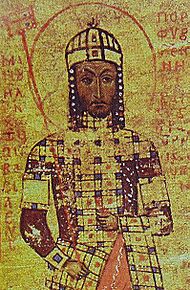
Béla arrived in Constantinople around late 1163. He was given a new name, Alexios. He also received the very high title of despotes. This title had only been used by emperors before. His engagement to Emperor Manuel's daughter, Maria, was also announced.
In 1164, Stephen III attacked Syrmium. Emperor Manuel led his army against Stephen. He said he was fighting "not to wage war on the Hungarians but to recover his land for Béla." Béla-Alexios joined the emperor on this campaign. A new peace treaty was signed, and Stephen III again gave up Béla's duchy. A Byzantine army then took over Syrmium.
Stephen III attacked Syrmium again in 1165. Emperor Manuel fought back, and Béla joined him. After the Byzantines recaptured Zimony (now Zemun in Serbia), Béla convinced the emperor not to execute the Hungarian soldiers captured there. The Byzantines also took over Dalmatia. Another peace treaty confirmed the Byzantine Empire's control over Béla's former lands. Dalmatia and Bosnia soon became Byzantine provinces.
In 1165, Emperor Manuel made his daughter and Béla-Alexios his official heirs. He made important Byzantine nobles promise loyalty to them. One of the emperor's cousins, Andronikos Komnenos, was upset by this. He asked why the emperor chose a "foreigner" to be the next emperor. Béla-Alexios also attended an important church meeting, the Council of Blachernae, in 1166.
In 1167, a new war started between Hungary and the Byzantine Empire. Some sources say Béla-Alexios "claimed the kingdom" of his brother. Many Hungarians even joined Béla-Alexios's army. On July 8, 1167, the Byzantine army defeated the Hungarians in the Battle of Sirmium. A peace treaty ended the wars and confirmed Byzantine rule over central Dalmatia, Bosnia, and Syrmium.
A New Title (1169–1172)
In 1169, Emperor Manuel's wife had a son named Alexios. This changed everything for Béla. The emperor ended his daughter's engagement to Béla-Alexios. He also took away Béla-Alexios's high title of despotes. Instead, he gave him the lower rank of kaisar.
In 1170, Béla-Alexios married Agnes of Antioch, who was the emperor's sister-in-law. They went on a trip to the Holy Land. In Jerusalem, they gave a large sum of money to the Knights Hospitaller as a thank you for their kindness. In a document from this time, Béla-Alexios called himself "Lord A., Duke of Hungary, Dalmatia and Croatia." This showed he still thought of himself as ruler of those lands, even though the emperor had given him a different title.
King of Hungary
Becoming King (1172–1173)
Béla's brother, King Stephen III, died on March 4, 1172. Some rumors said Stephen was poisoned by Béla's supporters, but this was never proven. A group of Hungarian leaders went to Emperor Manuel and Béla. They asked Béla to return and become their king. Emperor Manuel agreed after Béla promised to always support the emperor and the Byzantines. Béla also promised never to help the Serbians if they fought against the Byzantine Empire.
Béla and his wife arrived in Székesfehérvár in April or May. The Hungarian nobles and church leaders all chose Béla to be king. However, his coronation was delayed. Lucas, Archbishop of Esztergom, refused to crown him. The archbishop accused Béla of simony, which means trying to buy church positions or favors. Some historians think Archbishop Lucas also worried about Byzantine influence in Hungary under Béla.
Most nobles and church leaders still supported Béla. He asked Pope Alexander III for help. The Pope allowed the Archbishop of Kalocsa to crown Béla. So, Béla was crowned king on January 18, 1173. After his coronation, he officially confirmed that the archbishops of Esztergom had the right to crown future Hungarian kings. It's believed that the "Greek" and "Latin" crowns were combined into the Holy Crown of Hungary during his reign.
Early Challenges (1173–1178)
Archbishop Lucas of Esztergom was not happy with Béla. For a few years, Béla ignored him. Instead, the Archbishop of Kalocsa baptized Béla's first son, Emeric, in 1174. This was usually the job of the Archbishop of Esztergom.
Around 1174 or 1175, Béla imprisoned his younger brother, Géza. But Géza escaped and fled to Austria. When the Duke of Austria refused to send Géza back, Béla attacked Austria. He raided the land with the help of Soběslav II, Duke of Bohemia. Meanwhile, Béla sent soldiers to help Emperor Manuel fight against the Seljuks. However, their combined forces were defeated in the Battle of Myriokephalon in 1176.
In 1177, Géza tried to get help from the Holy Roman Emperor. But Soběslav II, Duke of Bohemia, captured Géza and handed him over to Béla. Béla imprisoned his brother again and also put their mother, Euphrosyne, in jail. The Holy Roman Emperor was angry at Soběslav for this. He removed Soběslav from power. Béla then stepped in and stopped the new Duke of Austria from attacking Bohemia.
Growth and Changes (1178–1194)
Around 1178, Béla had a disagreement with Andrew, Archbishop of Kalocsa, who had been his favorite. Béla took away Andrew's church positions and money. Pope Alexander III punished Béla for this. But Béla made peace with Archbishop Lucas of Esztergom, who then forgave Béla and punished Andrew. The conflict ended when Andrew asked Béla for forgiveness, and Béla gave him back his archbishop position.
Béla invited Cistercian monks from France to Hungary. They built new monasteries between 1179 and 1184. In the 1180s, Béla started building a grand royal castle and a new cathedral in Esztergom. These buildings were early examples of Gothic architecture in Central Europe.
Béla learned about good government from the Byzantine court. He made sure that written records were kept for all important decisions. This helped make the government more organized. He ordered in 1181 that a document, called a charter, must be written for all agreements made in his presence.
Emperor Manuel I died in 1180. Within six months, Béla took back control of Dalmatia. The people of Split and Zadar welcomed Hungarian rule. Historians believe Béla took Dalmatia peacefully, with the Byzantine Empire's agreement. They preferred Béla to rule it rather than the Republic of Venice.
Béla also took back Syrmium. In 1182, he attacked the areas of Belgrade and Barancs (in modern-day Serbia). This showed he had already taken Syrmium. In 1183, Béla advanced further into the Byzantine Empire, reaching Niš and Serdica (now Sofia in Bulgaria). In Serdica, he took the holy relics of Saint Ivan of Rila and brought them to Esztergom.
In 1183, the Byzantine Emperor Alexios II was murdered. Béla invaded the Byzantine Empire again in 1185. After a new emperor, Isaac II Angelos, took power, Béla signed a peace treaty. Isaac married Béla's daughter, Margaret. Béla gave the regions of Niš and Barancs to Isaac as his daughter's dowry. The relics of Saint Ivan of Rila were also returned to Serdica. In 1186, Béla married Margaret of France, who was the sister of Philip II of France.
In 1187, the Doge of Venice tried to capture Zadar, but failed. In 1188, Vladimir Yaroslavich, the Prince of Halych, fled to Hungary after his nobles rebelled. Béla invaded Halych and drove out the new prince. Instead of putting Vladimir back in charge, Béla imprisoned him. He gave control of Halych to his younger son, Andrew. Béla then called himself King of Galicia.
In 1189, German crusaders marched through Hungary, led by Frederick I, Holy Roman Emperor. Béla welcomed Frederick and sent soldiers to guide the crusaders. At Frederick's request, Béla released his brother Géza, who joined the crusaders and left Hungary. Béla also helped make peace between Frederick I and Isaac II, who almost went to war.
Vladimir Yaroslavich escaped from prison in 1189 or 1190. With help from Casimir II of Poland, he drove Andrew out of Halych. In 1191, Béla met his son-in-law, Isaac II, but what they discussed is unknown. In 1192, the Pope approved the canonization (making someone a saint) of Ladislaus I of Hungary at Béla's request.
In 1193, Béla invaded Serbia. Isaac II demanded that Béla's troops leave and threatened war. Around the same time, the Doge of Venice tried to take Zadar again, but failed. In 1193, Béla gave a territory in Croatia, called Modruš County, to a noble family. This was one of the first times a royal office was given as a family inheritance in Hungary.
Final Years (1194–1196)
In 1194, Béla made his oldest son, Emeric, who was already crowned as the future king, the ruler of Croatia and Dalmatia. After a large army of Bulgarians, Cumans, and Vlachs defeated the Byzantines in 1194, Béla wanted to help the Byzantine Empire. However, his plan was canceled because his son-in-law, Emperor Isaac II, was removed from power in 1195. The Henry VI, Holy Roman Emperor, planned to attack the Byzantine Empire to help the dethroned emperor. But Béla stopped his own people from joining Henry.
Béla promised to lead a crusade to the Holy Land. However, he became ill and died on April 23, 1196. He was buried in the Székesfehérvár Cathedral. Archeologists found his remains in the 19th century. They were sure it was him because an old source mentioned Béla's unusual height. His skeleton showed he was 190 cm (about 6 feet 3 inches) tall. Béla's remains were later reburied at the Matthias Church in Budapest. DNA from his bones suggests that the Árpád dynasty, to which Béla belonged, had a specific genetic marker (Y-haplogroup R1a subclade R-SUR51 > R-ARP).
Family Life
Béla's first wife was Agnes, daughter of Raynald of Châtillon, Prince of Antioch. Agnes was born around 1149 and died around 1184. When she married Béla in 1170, she was renamed Anna in Constantinople.
Béla and Agnes-Anna had several children:
- Emeric (born 1174), who became King of Hungary after his father.
- Margaret (born 1175), who was renamed Maria in Constantinople. At age nine or ten, she married the Byzantine Emperor Isaac II Angelos, who was much older. After his death, she married Boniface of Montferrat, a leader of the Fourth Crusade.
- Andrew (born around 1177), who later became King Andrew II.
- Two younger sons, Solomon and Stephen, who died as babies.
- Constance, who married King Ottokar I of Bohemia around 1198.
- Another daughter whose name is unknown and who died in infancy.
After Agnes-Anna died, Béla wanted to marry Theodora, a granddaughter of Emperor Manuel I's sister. But the Byzantine Church stopped the marriage in 1185 because Theodora had become a nun. Béla then tried to marry Matilda of Saxony in 1185 or 1186, but her grandfather, Henry II of England, prevented it. Finally, in 1186, Béla married Margaret of France. She was the daughter of Louis VII of France and had been married before. Queen Margaret outlived Béla and moved to the Holy Land after his death.
| Ancestors of Béla III of Hungary | |||||||||||||||||||||||||||||||||||||||||||||||||||||||||||||||||||||||||||||||||||||||||||||||||||||||||||||||||||||||||||||||||||||||||||||||||||||||||||||||||||||||||||||||||||||||||||||||||||||||||||||||||||||||||||||||||||||||||||||||||||||||||||||||||||||||||||||||||||||||||||||||||||||||||||||||||||||||||||||||||||||||||||||||||||||||||||||||||||||||||||||||||||||||||||||||||||||||||||||||||||||||||||||||||||||||||||||||||||||||||||||||||||||||||||||||||||
|---|---|---|---|---|---|---|---|---|---|---|---|---|---|---|---|---|---|---|---|---|---|---|---|---|---|---|---|---|---|---|---|---|---|---|---|---|---|---|---|---|---|---|---|---|---|---|---|---|---|---|---|---|---|---|---|---|---|---|---|---|---|---|---|---|---|---|---|---|---|---|---|---|---|---|---|---|---|---|---|---|---|---|---|---|---|---|---|---|---|---|---|---|---|---|---|---|---|---|---|---|---|---|---|---|---|---|---|---|---|---|---|---|---|---|---|---|---|---|---|---|---|---|---|---|---|---|---|---|---|---|---|---|---|---|---|---|---|---|---|---|---|---|---|---|---|---|---|---|---|---|---|---|---|---|---|---|---|---|---|---|---|---|---|---|---|---|---|---|---|---|---|---|---|---|---|---|---|---|---|---|---|---|---|---|---|---|---|---|---|---|---|---|---|---|---|---|---|---|---|---|---|---|---|---|---|---|---|---|---|---|---|---|---|---|---|---|---|---|---|---|---|---|---|---|---|---|---|---|---|---|---|---|---|---|---|---|---|---|---|---|---|---|---|---|---|---|---|---|---|---|---|---|---|---|---|---|---|---|---|---|---|---|---|---|---|---|---|---|---|---|---|---|---|---|---|---|---|---|---|---|---|---|---|---|---|---|---|---|---|---|---|---|---|---|---|---|---|---|---|---|---|---|---|---|---|---|---|---|---|---|---|---|---|---|---|---|---|---|---|---|---|---|---|---|---|---|---|---|---|---|---|---|---|---|---|---|---|---|---|---|---|---|---|---|---|---|---|---|---|---|---|---|---|---|---|---|---|---|---|---|---|---|---|---|---|---|---|---|---|---|---|---|---|---|---|---|---|---|---|---|---|---|---|---|---|---|---|---|---|---|---|---|---|---|---|---|---|---|---|---|---|---|---|---|---|---|---|---|---|---|---|---|---|---|---|---|---|---|---|---|---|---|---|---|---|---|---|---|---|---|---|---|---|---|---|---|---|---|---|---|---|---|---|---|---|---|---|---|---|---|---|---|---|---|---|---|---|---|---|---|---|---|---|---|---|---|---|
|
|||||||||||||||||||||||||||||||||||||||||||||||||||||||||||||||||||||||||||||||||||||||||||||||||||||||||||||||||||||||||||||||||||||||||||||||||||||||||||||||||||||||||||||||||||||||||||||||||||||||||||||||||||||||||||||||||||||||||||||||||||||||||||||||||||||||||||||||||||||||||||||||||||||||||||||||||||||||||||||||||||||||||||||||||||||||||||||||||||||||||||||||||||||||||||||||||||||||||||||||||||||||||||||||||||||||||||||||||||||||||||||||||||||||||||||||||||
Béla's Lasting Impact
Béla III was one of Hungary's most important medieval kings. His rule marked a high point for the Árpád dynasty. He made government more organized by creating the Royal Chancery, which led to more written records being used in Hungary. The first official documents from nobles appeared in the 1190s.
According to a list of Béla's income, he earned a huge amount of money each year. It was about 170,000 marks, which is like 23 tons of pure silver! If this list is accurate, his income was more than the kings of France and England at that time. However, many historians question if this list is truly reliable.
Around 1190, a fire destroyed Esztergom. Béla invited French builders to rebuild the royal palace and cathedral. These builders brought new architectural styles to Hungary. The new palace and cathedral were the first examples of Gothic architecture in Central Europe. Coins minted around 1190 showed a two-barred cross, which was common in the Byzantine Church. This suggests that the "double cross" became part of the Hungarian royal symbols during Béla III's reign.
Images for kids


